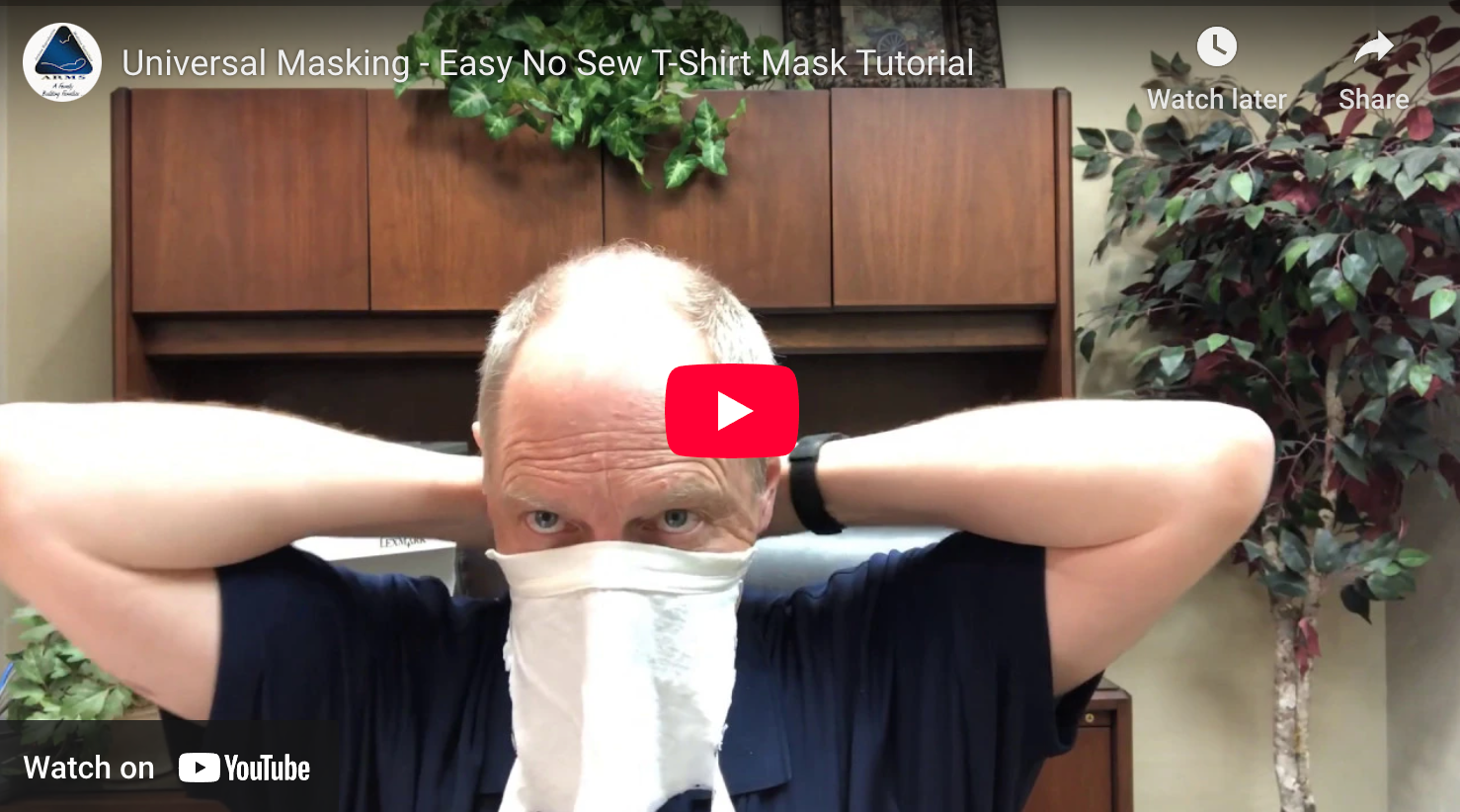Dr. Moffitt discusses universal masking during the coronavirus pandemic and shows you how to make your own mask!

Transcript
What is universal masking?
Universal masking is the idea where everybody in a certain space wears a mask. Now in that context, no single person is being protected from transmission from other people, but they
are limiting their ability to transmit the virus to others. If everybody in that space is wearing a surgical type mask then total transmission of the virus is reduced in that space.
So why is this not being recommended by the government? Well, it’s simply that there’s no way to immediately help everybody have access to a surgical type mask. There simply are not available for everybody to go out and buy a medical grade surgical mask. But what if you could make a mask in about 10 minutes from stuff you just have lying around the house?
Efficacy of homemade protective masks
Well, way back in 2013, after the H1N1 pandemic researchers investigated you know what stuff do we have around the house that might be able to reduce transmission of the virus. And they looked at lots of different things and basically concluded that the common 100% cotton t-shirt is the best thing that could reduce transmission of viral particles the size of the coronavirus.
So what they found in their tests was that a medical-grade surgical mask reduced transmission of particles the size of the new coronavirus about 89%. So it blocked 89% of viral transmission. But a common t-shirt blocked 70%.
So again, not as great as a medical-grade mask but a medical grade mask isn’t a hundred percent either. So it’s not perfect but it’s better than nothing and what we need right now is a better than nothing solution.
So what I’d like to do is show you how you can make a surgical type mask in about 10 minutes using just a pen, scissors and an old t-shirt in the back of your closet. All right here we go.
Making a mask out of a t-shirt
[gets materials, starts demonstrating how to cut the shirt to make a mask]
So here is an old t-shirt that I had in the back of my closet and the first thing you do is you look at the tag. The tag here it says 100% cotton – okay, so you got a 100% cotton t-shirt.
So the concept here is the t-shirt has some fundamental things that are going to help guide you and you’re going to be able to do this completely without using any type of measurements.
If you’re using a t-shirt that you already wear, in the end it will end up fitting you well because there are aspects about the size of the shirt that make it work well for sizing.
So the first thing you want to do is you want to end up making your first cut along this seam here. This is a stitch seam and it will provide the beginning of the ties you use to tie the mask. All right, so now you’ve made the first cut of your cloth. Now you want to go ahead and extend this back this way. But first we’re going to measure the mask dimensions okay?
Okay, so now that you’ve got your cut t-shirt you want to figure out how big is the distance from here to here [pointing at the shirt]. I think the easiest thing is to just place the collar part right under your chin and then let’s lift this up to the bridge of your nose like that and then pinch it off and I’ve got that held right here. And then I’m just going to make a cut right there and that’s going to give me the height or the distance of the mask itself okay?
The next thing I’m going to do is I want to figure out how thick the mask is. So the distance between the collar and this way so that distance is essentially the back of your jaw to the top of your ear.
So, you basically take that measurement so what I do is I lay down the mask like this and then I take this measurement and I keep that distance and I put it down on the mask, which I’ll show you. Alright, so now I have the mask all right now I have the cloth set out and I need to figure out what distance I’m going to have the mask be. So again, I take that measurement from my jaw to the top of my ear and I set it down here and I make a little mark with a sharpie okay, this is going to be the width of the mask this is the height of the mask right here that’s that cut I made okay? Then the next thing I want to do is the top ties. So, if you just take the width of your thumb right or from your knuckle to your thumb and you set that there. That’s going to be a good thickness for the top of that tie. So you just set that on there and the thickness for the top of the tie okay? Now you have all your measurements then you go ahead and draw a line from here to over here okay. And again, this isn’t rocket science. You want the other side to be this. This is going to be the top tie so the thickness from here to here and here to here. So, you can just kind of free draw that like that. Again this isn’t a rocket science. And so the next thing you want to do is you want to cut. This is going to be one tie and this is going to be the other tie. So you can just kind of extend this like this on this tie remember don’t cut the seam.
Alright now you have your mask okay? Okay, so how does this mask work?
Essentially you put the top part that has the collar over the top and take this around the back of your head, right around the base of your neck. And you tie that, then your going to take these longer ones around and tie those behind your back. Now you have a mask.
It has very good seals on the side, very good seals underneath and very good seal on the other side. And now you have a homemade surgical-type mask that can reduce the transmission of the virus.
Drew V. Moffitt, M.D., FACOG, has been a board-certified infertility specialist since 1999 and is currently the medical director of the Arizona Reproductive Medicine Specialists.
More information on the coronavirus

